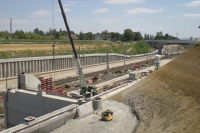Vienna - Salzburg High-Performance Railway Line,
St. Pölten Main Station
Client: Austrian Railways Infrastructure AG
Development Period: 2004 to 2012
As railway station of the provincial capital of Lower Austria, the St. Pölten main station is of great importance. Since this traffic junction already reached its capacity limits before the start of the planning, the remodelling is essential for the development of the municipal location.
The works comprised the renewal and extension of the railway sidings to eight through tracks. Furthermore, the section west of the station was straightened and developed into three main tracks.
In the course of a complete remodelling of the railway building, the Kremser road, which passed under the historic main entrance, had to be repositioned. Additionally, a new pedestrian underpass and a road bridge are included in the project.
All works had to be executed at full railway service.
For this project, BGG Consult carried out the consulting in the fields of geotechnics and hydrogeology during all planning and construction phases. After the commercial and technical supervision of subsoil exploration works, a geotechnical-hydrogeological expert's report for the permission procedure was compiled.
In the tendering phase, geotechnical expert's reports have been worked out for each of the contract sections.
Additionally, the checking of the detailed project from a geotechnical viewpoint and the dimensioning of retaining structures and building pit walls was included in the scope of work. During construction, the works were supervised on site with regard to geotechnics and hydrogeology. Furthermore, retaining structures (bored pile walls) and slopes were monitored using geodetic measuring points and eight inclinometers.
Retaining Structures Western Section:
In the section west of the station, the railway line crosses a geological fault zone, the so-called St. Pölten Fault. For this reason, particular attention had to be paid to the design and the dimensioning of the cut extensions, especially because of the high ground water level.
Therefore, the retaining structures were designed in form of intermittent bored pile walls with shotcrete noggings on both sides of the line.
Instabilities that occurred locally were secured by means of slope flattening, riprap or anchors. In this way, a cost-effective construction at a sufficient safety level could be secured.
May 2012
